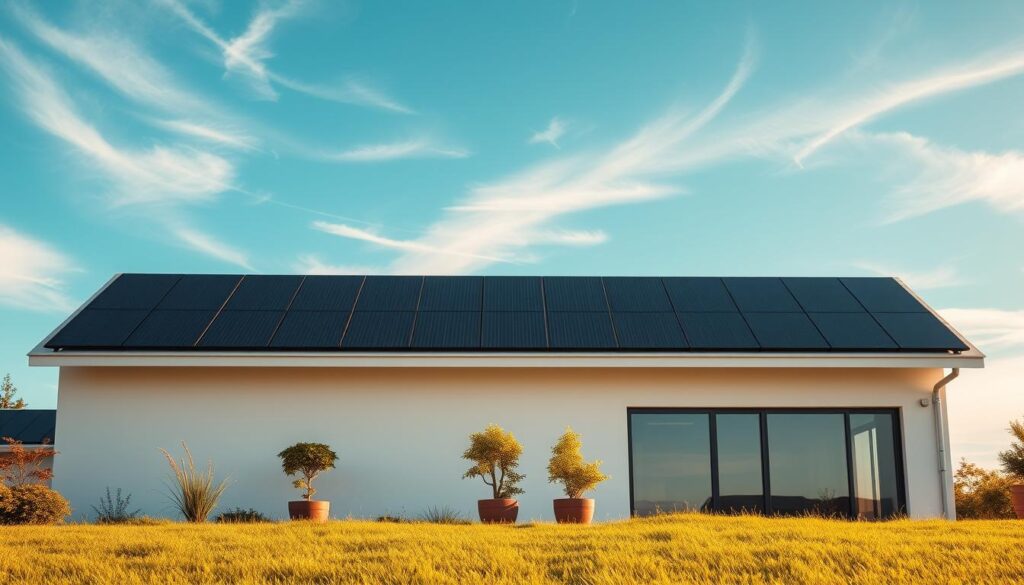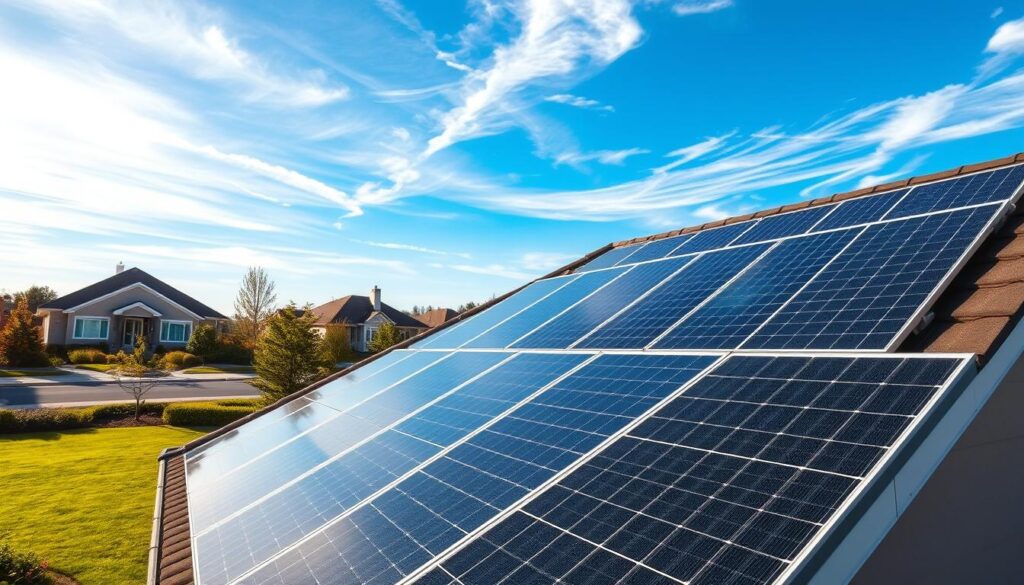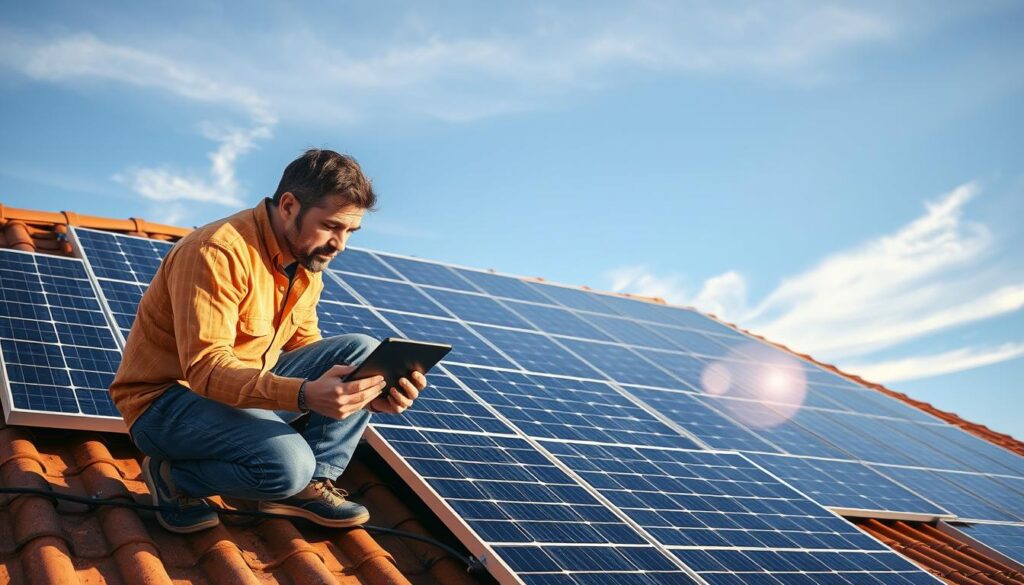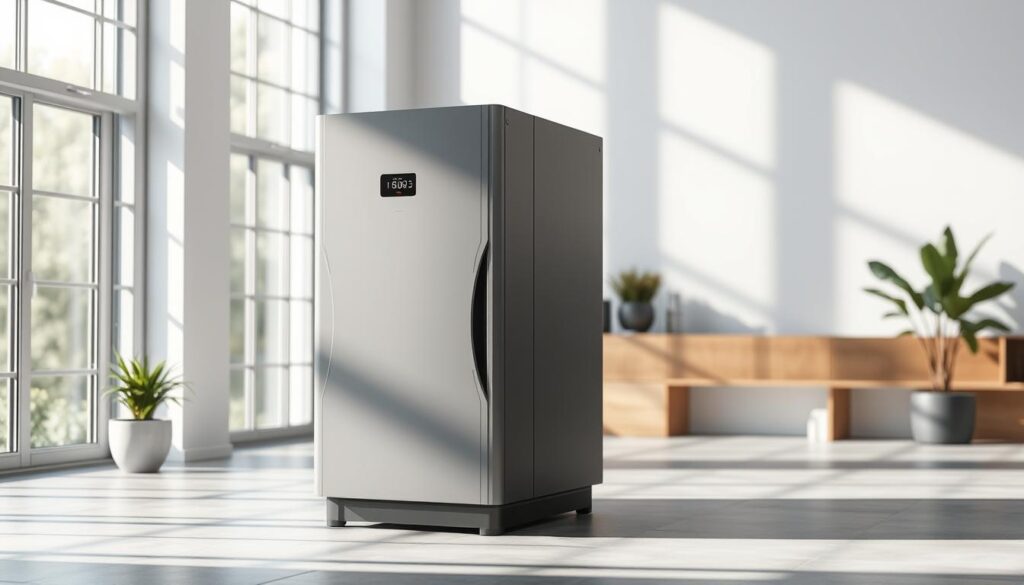Switching to renewable energy is easier than ever. Homeowners across the U.S. are embracing solar energy to power their lives sustainably. With rising utility costs and attractive incentives, it’s no wonder more people are making the switch.
Since 2008, advancements in technology have made solar projects more affordable and efficient. According to the Department of Energy, these improvements have significantly lowered installation costs. This means you can start saving on your electricity bills while reducing your carbon footprint.
Investing in solar energy not only cuts monthly expenses but also contributes to a cleaner environment. Early adopters have seen impressive savings, and with federal tax credits, the financial benefits are even greater. It’s a win-win for your wallet and the planet.
Ready to explore how solar energy can transform your lifestyle? Let’s dive into the benefits and opportunities waiting for you.
Key Takeaways
- Solar energy reduces monthly electricity bills and promotes sustainability.
- Technological advancements have made solar installations more affordable.
- Federal tax credits can cover up to 30% of installation costs.
- Homeowners can save thousands over the lifetime of their solar system.
- Solar energy helps reduce carbon emissions and supports a cleaner environment.
Introduction
Renewable energy is transforming how we power our lives. With a growing focus on sustainability, more households are exploring ways to reduce their carbon footprint and save on utility bills. One of the most effective solutions is harnessing the power of the sun through solar panels.
Overview of Renewable Energy at Home
Renewable energy comes from natural sources like sunlight, wind, and water. These resources are abundant and can be replenished, making them a sustainable alternative to fossil fuels. For homeowners, adopting renewable energy means reducing reliance on traditional power grids and contributing to a cleaner environment.
Solar panels, in particular, have become a popular choice. They convert sunlight into electricity, providing a low-emission energy source. According to the Department of Energy, advancements in technology have made these systems more efficient and affordable than ever before.
Why Consider Solar Panels?
Switching to solar panels offers both financial and environmental benefits. First, they can significantly lower your monthly electricity bills. Over time, the savings can add up to thousands of dollars. Second, solar energy reduces greenhouse gas emissions, helping combat climate change.
Additionally, federal tax credits can cover up to 30% of installation costs, making it a smart investment for long-term savings. With a lifespan of over 25 years, solar panels provide reliable energy while supporting energy independence.
| Benefit | Details |
|---|---|
| Cost Savings | Reduces monthly electricity bills by up to 50%. |
| Environmental Impact | Lowers carbon footprint by reducing greenhouse gas emissions. |
| Incentives | Federal tax credits cover 30% of installation costs. |
| Energy Independence | Provides reliable power, even during outages. |
By choosing solar panels, you’re not just saving money—you’re also making a positive impact on the planet. It’s a decision that benefits both your wallet and the environment.
Understanding Home Solar Cells
Harnessing the sun’s energy has become a practical solution for modern households. These systems are designed to convert sunlight into electricity, offering a sustainable way to power your daily needs. By integrating panels into your property, you can take control of your energy consumption and reduce reliance on traditional grids.

What Are Home Solar Cells?
Solar cells, often grouped into panels, are the building blocks of a residential energy system. Each panel contains multiple cells that capture sunlight and convert it into usable electricity. When combined, these panels form a complete system that powers your home efficiently.
Most modern panels are made from silicon, a durable and abundant material. They are designed to last over 25 years, maintaining more than 80% of their original efficiency. This makes them a reliable long-term investment for homeowners.
Key Benefits for Homeowners
Installing a solar system offers numerous advantages. First, it significantly reduces monthly electricity bills. On average, homeowners save around $1,500 annually, making the system pay for itself in about 10 years.
Second, solar energy is environmentally friendly. It reduces greenhouse gas emissions, helping combat climate change. Additionally, homes with panels often see an increase in property value, selling for an average of 6.8% more than non-solar homes.
Finally, federal tax credits can cover up to 30% of installation costs, making it more affordable to switch to clean energy. With a 25-year warranty on many systems, you can enjoy peace of mind knowing your investment is protected.
Compared to traditional power sources, solar systems produce energy at a consistent rate, even during peak demand. This makes them a reliable and sustainable choice for modern households.
Assessing Your Home’s Solar Energy Needs
Evaluating your roof’s suitability ensures optimal energy production. Before diving into a renewable energy project, it’s essential to understand your household’s energy consumption and available space. This step-by-step guide will help you determine the right system size and placement for your needs.
Calculating Your Energy Consumption
Start by reviewing your electricity bills from the past year. Look for your monthly and annual energy usage, typically measured in kilowatt-hours (kWh). This data provides a clear picture of your energy needs.
For example, if your air conditioner uses 2 kilowatts and runs for 5 hours daily, it consumes 10 kWh each day. Multiply this by 30 days to estimate monthly usage. Add up all appliances to get a total figure.
Here’s a quick breakdown of average energy needs:
- Small homes (500-800 kWh/month): 4-6 kW system.
- Medium homes (800-1,200 kWh/month): 6-8 kW system.
- Large homes (1,200+ kWh/month): 8-12+ kW system.
Once you have your total consumption, consider increasing the calculated system size by 10% to 20% to account for efficiency losses.
Evaluating Roof Space and System Size
Your roof plays a critical role in determining the success of your project. Start by measuring the available space. Most panels require about 17.5 square feet each. For example, a 1,000 sq ft roof can typically accommodate 19 panels.
Next, assess the roof’s orientation and shading. South-facing roofs are ideal in the U.S., as they receive the most sunlight. East or west-facing options can also work but may produce less energy. Avoid north-facing roofs if possible.
Consider structural integrity as well. Panels weigh around 40 pounds each, so ensure your roof can support the added load. Consulting with a certified installer can help address these concerns.
| Factor | Consideration |
|---|---|
| Roof Space | Measure available area; panels require ~17.5 sq ft each. |
| Orientation | South-facing roofs are optimal for maximum energy production. |
| Shading | Minimize obstructions like trees or chimneys to avoid efficiency losses. |
| Structural Integrity | Ensure the roof can support the weight of the panels. |
By carefully assessing your energy needs and roof characteristics, you can design a system that maximizes efficiency and savings. Tailoring the solution to your specific requirements ensures long-term success.
Planning and Designing Your Solar Installation
Designing a renewable energy setup requires careful planning and consideration. Whether you’re aiming for energy independence or simply reducing your carbon footprint, choosing the right system type is essential. This section will guide you through the key decisions, from grid-tied vs. off-grid options to mounting methods.

Grid-Tied vs Off-Grid Options
Grid-tied systems are connected to the local power grid, allowing you to draw electricity when you need it and send excess energy back. This type of setup often qualifies for net metering, which can further reduce your bills. On the other hand, off-grid systems provide complete energy independence, making them ideal for remote locations.
Off-grid systems require batteries to store energy, adding to the upfront cost. However, they eliminate reliance on the grid, ensuring power during outages. Grid-tied systems are typically more affordable and easier to maintain, but they depend on grid availability.
Roof-Mounted vs Ground-Mounted Systems
Roof-mounted systems are the most common, utilizing existing space without additional land use. They are cost-effective and blend seamlessly with your property. However, they require a structurally sound roof and may face shading issues.
Ground-mounted systems offer flexibility in placement, ensuring optimal sunlight exposure. They are easier to access for maintenance and can be expanded as needed. While they take up more space, they often achieve higher production efficiency.
Recent advancements in technology have made both options more efficient and affordable. For example, innovative designs like tracking systems can maximize energy output by following the sun’s path. These trends are reshaping how we approach renewable energy setups.
By understanding your energy needs and property layout, you can choose the best system type for your goals. Whether you prioritize cost, efficiency, or independence, careful planning ensures a successful solar installation.
Step-by-Step Home Solar Cells Installation Guide
Taking the leap into renewable energy starts with a well-planned installation process. Whether you’re going solar for the first time or upgrading your system, understanding the steps involved ensures a smooth and safe experience. From securing permits to connecting components, this guide walks you through the essentials.
Preparation, Permits, and Safety Considerations
Before starting, check local regulations. Most areas require a building permit and an interconnection agreement. A licensed contractor may need to apply for these on your behalf. Safety is paramount, so always wear protective gear like gloves, eye protection, and closed-toe boots.
Create a checklist of components, including panels, an inverter, and wiring. Measure your roof space and ensure it can support the weight of the system. South-facing roofs are ideal for maximum sunlight exposure. Avoid shading from trees or chimneys to maintain efficiency.
DIY Installation Tips and Best Practices
If you’re opting for a DIY approach, start by mounting the panels securely. Use universal connectors like MC4 for compatibility. Connect the panels in series or parallel, depending on your energy needs. Always follow the National Electric Code (NEC) guidelines for wiring and grounding.
Integrate a battery storage system to store excess energy. This ensures power during outages and maximizes usage. Use a multimeter to check voltage levels before making electrical connections. Label all components clearly for easy maintenance.
- Plan the layout carefully to avoid shading and maximize sunlight.
- Double-check all connections to ensure safety and efficiency.
- Keep an array map of micro-inverters for monitoring performance.
By following these steps, you can enjoy the benefits of a solar panel system while ensuring safety and compliance. Proper planning and attention to detail make all the difference in achieving a successful installation.
Maintenance and Optimization of Your Solar System
Keeping your energy system in top shape ensures long-term performance and savings. Regular care not only extends the lifespan of your setup but also maximizes its efficiency. By following a few simple steps, you can enjoy consistent energy production and reduce unnecessary costs.

Routine Cleaning and Inspection
Dirt and debris can reduce the efficiency of your solar power setup by up to 20%. Cleaning panels twice a year, especially in dusty areas, helps maintain optimal performance. Use a soft brush or hose to remove buildup, and avoid harsh chemicals that could damage the surface.
Periodic inspections are equally important. Check for cracks, loose wiring, or shading from nearby trees. “A well-maintained system ensures uninterrupted energy flow,” says a leading industry expert. Schedule professional check-ups every two years to identify and fix potential issues early.
Maximizing Efficiency and Energy Production
Small adjustments can lead to significant savings. Adjust the angle of your panels four to five times a year to capture maximum sunlight. South-facing setups are ideal, but even west-facing panels can boost output during peak hours.
Monitor your system’s performance regularly. A drop in energy production could indicate a malfunctioning inverter or wiring issue. Investing in module-level microinverters can mitigate shading effects and improve overall efficiency.
By staying proactive, you can ensure your energy system operates at its best, delivering reliable power and long-term financial benefits.
Integrating Solar Energy with Battery Storage
Energy independence becomes achievable with the right storage systems in place. By combining solar panels with efficient batteries, you can ensure a reliable power supply even during outages. This integration not only enhances your energy system’s performance but also provides peace of mind during emergencies.

Choosing Suitable Battery Options
Selecting the right battery is crucial for maximizing your energy system’s potential. Lithium-ion batteries are the most popular choice due to their high efficiency and long lifespan. They are ideal for residential setups, offering a balance between cost and performance.
Other options include lead-acid and redox flow batteries. Lead-acid batteries are more affordable but have a shorter lifespan. Redox flow batteries, while expensive, are highly durable and scalable. Consider your energy needs and budget when making a decision.
Enhancing Energy Independence During Outages
Battery storage systems provide a reliable way to maintain power during grid outages. When the grid goes down, your stored energy can keep essential appliances running. This is especially valuable in areas prone to natural disasters or frequent power disruptions.
Integrating batteries with your solar setup also allows you to store excess energy generated during peak sunlight hours. This stored energy can be used at night or during cloudy days, reducing reliance on the utility grid. It’s a smart way to optimize energy use and lower costs.
| Battery Type | Advantages | Considerations |
|---|---|---|
| Lithium-ion | High efficiency, long lifespan | Higher upfront cost |
| Lead-acid | Affordable, widely available | Shorter lifespan, requires maintenance |
| Redox Flow | Durable, scalable | Expensive, complex installation |
By integrating battery storage with your solar system, you gain greater control over your energy usage. This setup not only enhances reliability but also supports a sustainable lifestyle. With federal tax credits covering up to 30% of installation costs, it’s a smart investment for long-term savings.
Cost Considerations and Financing Solar Projects
Understanding the financial side of renewable energy projects is key to making informed decisions. From installation costs to incentives, breaking down the expenses helps homeowners plan effectively. Let’s explore the costs, financing options, and savings opportunities available.
Understanding Installation and Equipment Costs
The price of a renewable energy system depends on its size and components. On average, a 6kW system costs between $14,100 and $21,240 before incentives. Larger systems, like an 11kW setup, can cost around $22,022 after federal tax credits.
Equipment costs include panels, inverters, and mounting hardware. Soft costs, like permits and labor, also play a role. “Investing in quality equipment ensures long-term savings,” says a leading industry expert. Always compare quotes from reputable companies to find solar solutions that fit your budget.
Exploring Incentives, Tax Credits, and Savings
Federal tax credits can significantly reduce your upfront costs. For systems installed between 2022 and 2032, the credit covers 30% of the total price. Many states also offer additional incentives, making renewable energy more affordable.
Financing options include:
- Loans: Personal loans or home equity loans with competitive rates.
- Leases: Pay a fixed monthly fee without owning the system.
- Power Purchase Agreements (PPAs): Buy energy at a lower rate from a solar company.
By leveraging these options, you can lower your monthly bill and enjoy long-term savings. With a payback period of about 10 years, renewable energy is a smart financial choice.
Exploring Advanced Solar Panel Technologies
The future of energy is being reshaped by groundbreaking advancements in technology. From record-breaking efficiency rates to innovative designs, the renewable energy landscape is evolving rapidly. Let’s dive into the latest trends and innovations that are driving this transformation.
Latest Trends in Efficiency and Technology
Recent breakthroughs have pushed the boundaries of what’s possible. For example, Maxeon 7 and Tiger Neo 3.0 panels have achieved efficiency rates nearing 50% in lab tests. These advancements are closing the gap between theoretical performance and real-world results under the sun.
Bifacial panels are another game-changer. They can generate up to 20% more energy by capturing sunlight on both sides. This technology is particularly effective in reflective environments, making it a smart choice for diverse installations.
Perovskite panels are also gaining traction. They offer enhanced light absorption and are more cost-effective than traditional silicon-based options. With ongoing research, these panels could soon dominate the market.
Innovations Driving the Future of Solar Energy
Beyond panels, advancements in energy storage are revolutionizing the industry. Newer batteries can store up to 80% of the energy generated during the day, ensuring a steady source of power at night or during cloudy conditions. This is a significant step toward energy independence.
Floating solar farms are another exciting development. They reduce water evaporation by 90% while generating energy, optimizing space utilization on water surfaces. This innovation is particularly valuable in areas with limited land availability.
AI-driven optimization is also making waves. By improving energy distribution, these systems can enhance overall performance by up to 15%. This technology ensures that every ray of sun is used efficiently.
As we look ahead, the next year promises even more exciting developments. From customizable solar skins to building-integrated photovoltaics, the possibilities are endless. Understanding these innovations empowers homeowners to make informed choices and embrace a sustainable future.
Conclusion
Embracing clean energy solutions has never been more rewarding. By adopting a solar panel home setup, you can significantly reduce your electricity bills while contributing to a greener planet. The process, from assessing your energy needs to installation and maintenance, is straightforward and backed by advanced technology.
Modern solar array systems are more efficient and affordable than ever. With federal tax credits covering up to 30% of costs, the financial benefits are substantial. Over time, these systems pay for themselves, offering long-term savings and energy independence.
Take the next step toward sustainable living. Explore the options available for a solar panel home and consider upgrading to a cutting-edge solar array. The future of energy is here—make it yours today.
